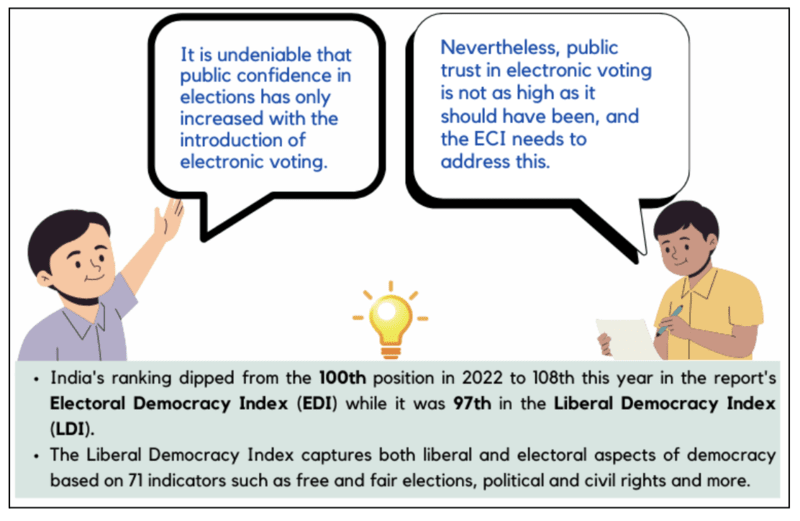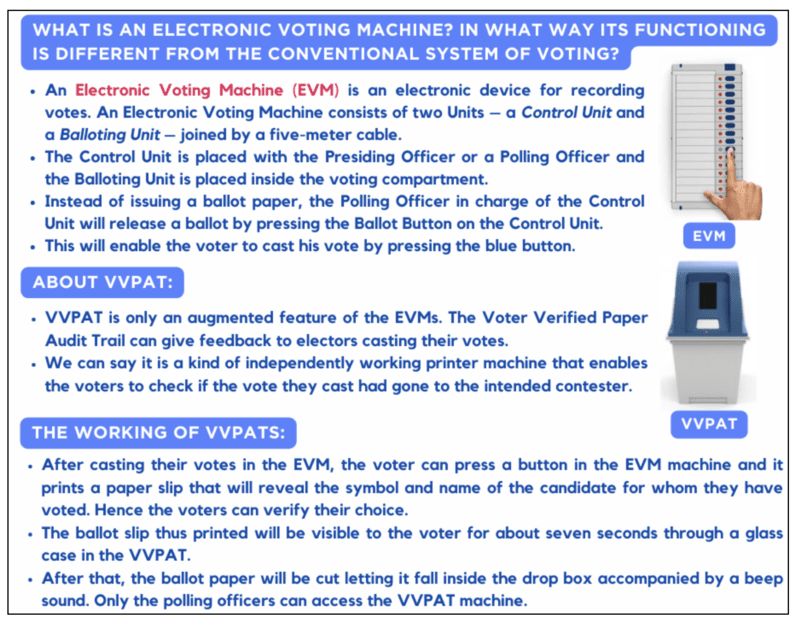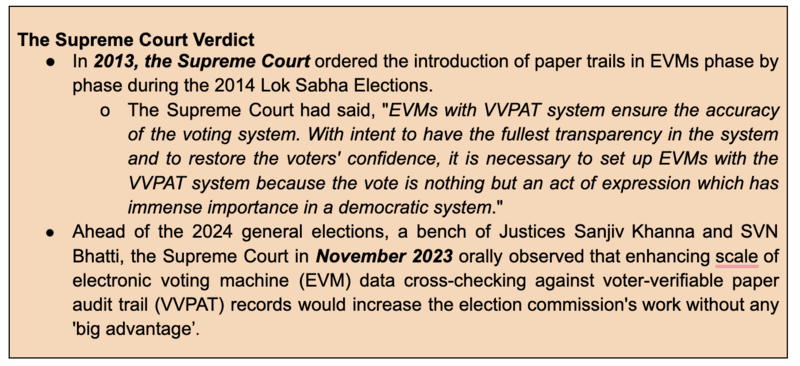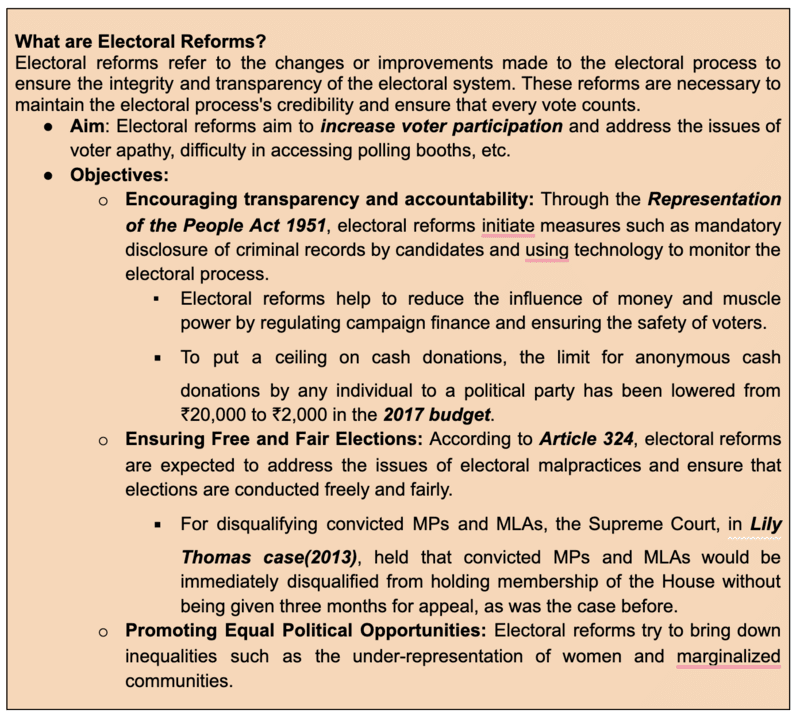EVMs are reliable — but the Election Commission must prove that
“Man's capacity for justice makes democracy possible, but man's inclination to injustice makes democracy necessary.” — Reinhold Niebuhr
Relevance: GS II (Polity and Governance)
- Prelims: EVM; VVPAT; Election Commission of India;
- Mains: Election Commission of India;
Why in the News?
There are continuous public debates, suspicion, and court cases around EVMs and VVPATs.

Recent criticisms associated with the VVPAT machines:
- They are not verified holistically: ECI’s current voter-verified paper audit trail (VVPAT) system is not truly voter-verified.
- India requires electronic voting, not only for efficiency but also to ensure correctness. There is no logical reason to trust the custody chain of ordinary paper ballots more, which perhaps is far easier to corrupt than EVMs.
- The correct protocol would be to allow a vote to approve the VVPAT slip before the vote is finally cast, and provide an option to cancel.
- There are chances for malpractices: During the Madhya Pradesh Assembly elections, allegations of malpractice were raised ahead of the counting of votes, when a video emerged of officials sorting ballot papers from the strong room in Balaghat.

Challenges:
- Limitations on Testing: The testing is never adequate to establish the correctness of an EVM, and tests can detect only a small fraction of possible software or hardware errors.
- Also, verifying the signature of the source code or embedded software does not guarantee the integrity of an EVM.
- Un-surety about functionality: If the correctness of an EVM cannot be established, then it is impossible to predict whether an EVM can be hacked or not, or determine whether all EVMs used in an election are identical in functionality.
- Also, that an EVM has not yet been hacked provides no guarantee whatsoever that it cannot be hacked.
- And, the onus of proving correctness is on the ECI, and not on hackers; that is not how computer security is argued. Thus, elections must be conducted assuming that the EVMs may be tampered with.

Way Forward:
- Independent Software needed: The primary way to ensure the correctness is to make the voting protocol software independent, as suggested by Ron Rivest in a paper, “Philosophical Transactions of the Royal Society”. It is proposed that software-independent voting systems should be preferred, and software-dependent voting systems should be avoided.
- This is not to say that software cannot be used, but that an undetected change in software or hardware should not cause an undetectable change in the election outcome.
- Need for secured programming: Various civil society demands that source code should be made public, or that EVMs should be standalone and use only one-time programmable chips, etc., only serve to detract from the main issue.
- Even if all these demands are met (and they should be), an EVM will still not be software-independent and hence not verifiable.
- Implementing established standards for Verification:
-
- Risk-Limiting Audit (RLA): There are standard and well-established methods called Risk-Limiting Audit (RLA) for cross-checking the electronic tally with VVPAT counts. The current stipulation of auditing five EVMs per assembly constituency is without any statistical basis.
- RLA verifies, with high confidence and efficiency, that the declared outcome matches the one that would have been determined with a full manual count of the VVPATs.
- Several electronic voting protocols measure up to such standards, but all use cryptographic commitments.
- They thus fail the test stipulated by the German Constitutional Court in 2009 that an election process is valid only if all its essential steps can be ascertained by the common man, without requiring any special knowledge or certification from experts. EVMs also fail the test.
- Risk-Limiting Audit (RLA): There are standard and well-established methods called Risk-Limiting Audit (RLA) for cross-checking the electronic tally with VVPAT counts. The current stipulation of auditing five EVMs per assembly constituency is without any statistical basis.
- Need for independent State funding: As recommended by the Law Commission of India (1999), this solution can foster fair competition by preventing certain parties or candidates from gaining undue advantages based solely on their financial resources.
- Promoting fair competition: Reduced dependence on private donors may lead to greater independence for elected representatives, allowing them to focus on public interests rather than catering to the interests of major donors.
Conclusion:
The incessant and disorderly public debates, suspicion, and court cases around EVMs and VVPATs are certainly not good for democracy. Elections should not only be fair but also need to appear fair. The Election Commission of India (ECI) should endeavor to put all doubts to rest. To engender complete public trust, elections need to be demonstrably and publicly verifiable.
BEYOND EDITORIAL

Mains PYQ
Q. In the light of recent controversy regarding the use of Electronic Voting Machines (EVM), what are the challenges before the Election Commission of India to ensure the trustworthiness of elections in India? (UPSC 2018)
Q. To enhance the quality of democracy in India the Election Commission of India has proposed electoral reforms in 2016. What are the suggested reforms and how far are they significant to make democracy successful? (UPSC 2017)
Prelims PYQs
Q. Consider the following statements: (UPSC 2017)
- The Election Commission of India is a five-member body.
- Union Ministry of Home Affairs decides the election schedule for the conduct of both general elections and bye-elections.
- Election Commission resolves the disputes relating to splits/mergers of recognized political parties.
Which of the statements given above is/are correct?
(a) 1 and 2 only
(b) 2 only
(c) 2 and 3 only
(d) 3 only


